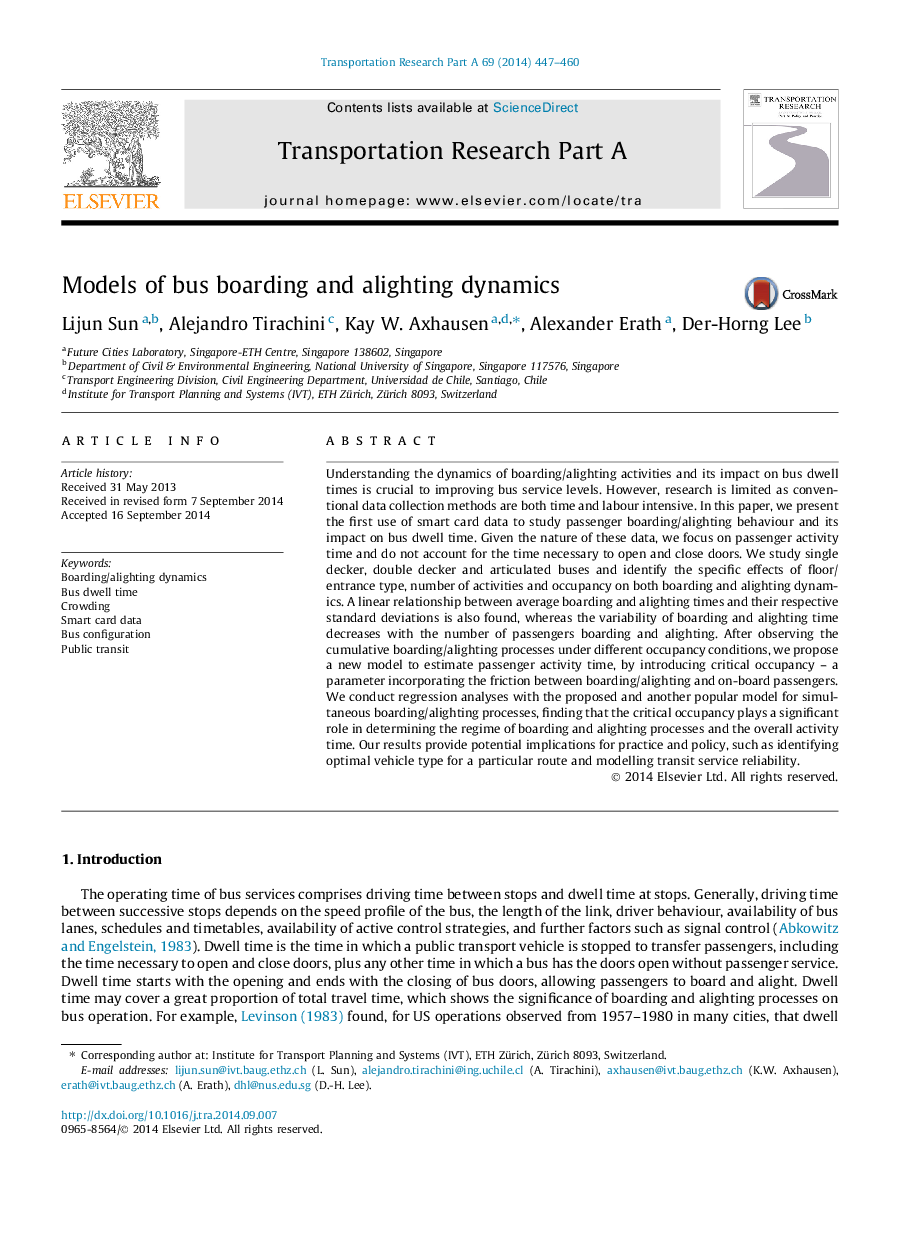| کد مقاله | کد نشریه | سال انتشار | مقاله انگلیسی | نسخه تمام متن |
|---|---|---|---|---|
| 6781599 | 533343 | 2014 | 14 صفحه PDF | دانلود رایگان |
عنوان انگلیسی مقاله ISI
Models of bus boarding and alighting dynamics
ترجمه فارسی عنوان
مدل های سوار شدن اتوبوس و پویایی هواپیما
دانلود مقاله + سفارش ترجمه
دانلود مقاله ISI انگلیسی
رایگان برای ایرانیان
کلمات کلیدی
پیمانکاری شبانه / هواپیما، زمان اتوبوس پرتاب کردن اطلاعات کارت هوشمند، پیکربندی اتوبوس، حمل و نقل عمومی،
ترجمه چکیده
درک پویایی فعالیت های شبانه روزی / پرواز و تاثیر آن در زمان اتوبوس های اتوبوس برای بهبود سطح خدمات اتوبوسرانی ضروری است. با این حال، تحقیق محدود به عنوان روش های جمع آوری داده ها هر دو زمان و کار نیرومندی هستند. در این مقاله ابتدا استفاده از داده های کارت هوشمند برای بررسی رفتار سوار شدن / سوار شدن مسافر و تاثیر آن بر زمان اتوبوس اتوبوس ارائه می شود. با توجه به ماهیت این اطلاعات، ما بر روی زمان فعالیت مسافر تمرکز می کنیم و برای زمان لازم برای باز کردن و بستن درب ها حساب نمی کنیم. ما به بررسی اتوبوس های تک اتوبوس، دو طبقه و اتوبوس ها می پردازیم و اثرات خاصی از نوع طبقه / ورودی، تعداد فعالیت ها و اشغال را در هر دو سواری و پرواز پویایی مشخص می کنیم. یک رابطه خطی بین میانگین زمان سوار شدن و زمان پرواز و انحراف استاندارد مربوطه نیز در بر دارد، در حالی که تغییر زمان سوار شدن و خروج با تعداد مسافران سوار شدن و خروج کاهش می یابد. پس از مشاهده فرایندهای سوار شدن / خروج تجمعی تحت شرایط مختلف مسکن، ما پیشنهاد مدل جدیدی را برای برآورد زمان فعالیت مسافر پیشنهاد می کنیم، با معرفی کرایه های بحرانی - پارامتر اصطکاک بین مسافران سواری / پرواز و مسافران در هواپیما. ما تجزیه و تحلیل رگرسیون را با مدل پیشنهادی و دیگر محبوب برای فرآیند شبانه روزی / پرواز به طور همزمان انجام می دهیم و می بینیم که جذب حیاتی نقش مهمی در تعیین رژیم فرماندهی شبانه روزی و پرواز و زمان فعالیت کلی دارد. نتایج ما پیامدهای بالقوه ای برای تمرین و سیاست، از قبیل شناسایی نوع وسیله نقلیه مطلوب برای یک مسیر خاص و قابلیت اطمینان مدل حمل و نقل، را فراهم می کند.
موضوعات مرتبط
مهندسی و علوم پایه
سایر رشته های مهندسی
مهندسی عمران و سازه
چکیده انگلیسی
Understanding the dynamics of boarding/alighting activities and its impact on bus dwell times is crucial to improving bus service levels. However, research is limited as conventional data collection methods are both time and labour intensive. In this paper, we present the first use of smart card data to study passenger boarding/alighting behaviour and its impact on bus dwell time. Given the nature of these data, we focus on passenger activity time and do not account for the time necessary to open and close doors. We study single decker, double decker and articulated buses and identify the specific effects of floor/entrance type, number of activities and occupancy on both boarding and alighting dynamics. A linear relationship between average boarding and alighting times and their respective standard deviations is also found, whereas the variability of boarding and alighting time decreases with the number of passengers boarding and alighting. After observing the cumulative boarding/alighting processes under different occupancy conditions, we propose a new model to estimate passenger activity time, by introducing critical occupancy - a parameter incorporating the friction between boarding/alighting and on-board passengers. We conduct regression analyses with the proposed and another popular model for simultaneous boarding/alighting processes, finding that the critical occupancy plays a significant role in determining the regime of boarding and alighting processes and the overall activity time. Our results provide potential implications for practice and policy, such as identifying optimal vehicle type for a particular route and modelling transit service reliability.
ناشر
Database: Elsevier - ScienceDirect (ساینس دایرکت)
Journal: Transportation Research Part A: Policy and Practice - Volume 69, November 2014, Pages 447-460
Journal: Transportation Research Part A: Policy and Practice - Volume 69, November 2014, Pages 447-460
نویسندگان
Lijun Sun, Alejandro Tirachini, Kay W. Axhausen, Alexander Erath, Der-Horng Lee,
